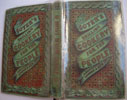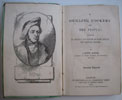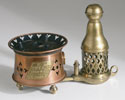Soyer's Shilling Cookery for the People.
A SHILLING COOKERY FOR THE PEOPLE EMBRACING AN ENTIRELY NEW SYSTEM OF PLAIN COOKERY AND DOMESTIC ECONOMY. BY ALEXIS SOYER AUTHOR OF "THE MODERN HOUSEWIFE" ETC. ETC. Seventieth Thousand. LONDON: GEO, ROUTELDGE & CO., FARRINGDON STREET. NEW YORK: 18, BEEKMAN STREET. 1855. The author of this work reserves the right of translating it.
Front paste-down and endpaper, recto and verso, with advertisements. [1] Frontispiece of Soyer with signature. Title page. [1] 1pp. Dedication to The Earl of Shaftsbury. [1] vii-viii. Preface. ix-x. Contents. 1-5 Introductory Letters. [1] 7-177. 178-182 Appendix. 1pp. Soyer's Kitchen for the Army. 184-190 Index. 1-6 Advertisements. 2pp Omission. 1-16. Advertisements. Back endpapers, recto and verso, and paste-down with advertisements. Covers and spine with original illustrations in very good condition. Very slightly rubbed. Internally very clean, almost as new. Back guttering slightly cracked but holding. A nice item especially in this original condition.
- During the first half of the nineteenth century, Alexis Soyer (1809-1858), a Frenchman, was the most famous cook and one of the most famous men in London. A combination of self-promotion, talent and energetic social conscience took him into many of the great events of his times. Through each phase of his meteoric career we can see a different aspect of nineteenth-century life, including the destruction of the English peasantry, the growth of London's private clubs, the Irish famine, the Great Exhibition and Britain's disastrous involvement in the Crimea. Soyer rose from obscure origins to early fame in his 20s, as private chef to England's nobility and then as chef de cuisine at London's new Reform Club. A combination of chef, inventor and cookbook author, Soyer designed a kitchen at the club so innovative that it became a tourist attraction, filled with his clever inventions: the first to use gas for stove-top cookery (preventing the carbon monoxide poisoning by charcoal cooking that had killed previous chefs such as Carême), to the drainer and the multi-egg poacher. He went on to open London's first real restaurant in conjunction with the Great Exhibition in 1851. A dashing figure (wearing clothes in flamboyant colours, cut on the bias, or in his parlance - 'ala zoug-zoug'), who never remarried after the tragic death of his first wife and child during childbirth, Soyer was linked to some of the most famous and beautiful actresses and dancers of the day. For all his flamboyance, Soyer was practical and big-hearted, writing cookbooks for the poor and designing his famous 'Magic Stove' (see image 5 below) and progressing the idea further by designing a very large stove for a model soup-kitchen which which he used in Ireland during the potato famine. In 1855 he went to the Crimea to take over the running of the kitchens in Florence Nightingale's hospital at Scutari, having first designed a new army cook-stove, a design that remained in use up until the first Gulf war. When he died in 1858, he was helping Florence Nightingale reform British army catering. Soyer's ‘Shilling Cookery for the People’ and his other famous cookery books, are a testament to this remarkable man who was determined to revolutionize the culinary world and who remains one of the greatest cooks of the nineteenth century. A Shilling Cookery for the People was first printed in 1855. Soyer, who agreed not to attach his name to any other cookery book at a similar or lower price, received £50 for the first edition of 10,000 copies. Within four months sales had reached 110,000, and by 1867 more than a quarter of a million copies had been sold. This edition states “seventieth thousand” on the title page which places it in the third month of the first printing of 1855.





click on image to enlarge

Antiquarian category
ref number:
11002